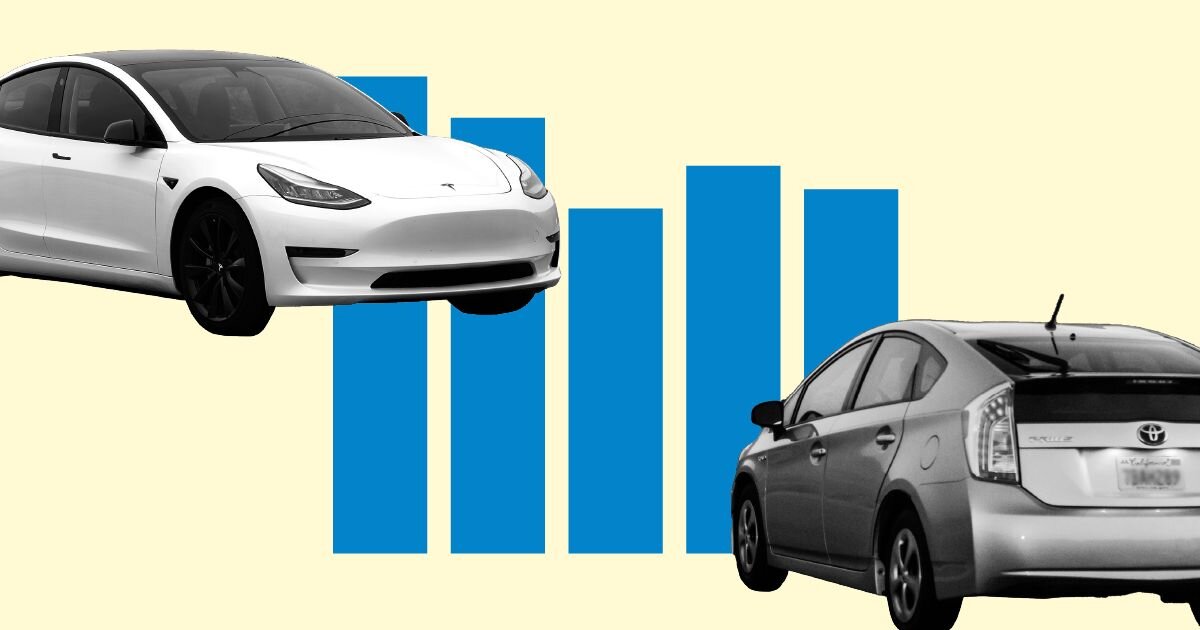Americans are traveling more and more miles in their cars.
At the same time, transportation sector greenhouse gas emissions are rising.
Vehicle miles traveled by light-duty vehicles — which include passenger cars and smaller trucks — increased 47% between 1990 and 2022. And in 2022, transportation accounted for the most greenhouse gas emissions of any sector in the US: 28%. Light-duty vehicles were the largest source of emissions in this sector.
The US has invested in electric vehicle production to curb rising emissions, setting a goal to reach 50% electric vehicle sales by 2030.
What are electric vehicles? What types are there?
The Energy Department defines electric-drive vehicles as those that “use electricity as their primary power source or to improve the efficiency of conventional vehicle designs.” Electric-drive vehicles fall into three categories under this definition:
- Hybrid electric vehicles (HEVs) are powered by a conventional gasoline or diesel engine and by an electric motor that uses energy from both the engine and a battery. The engine powers the battery’s charge.
- Plug-in hybrid electric vehicles (PHEVs) are like HEVs but have an extra battery for the option of electric-only driving. They can run on gas alone but must be plugged in to use their electric features.
- All-electric vehicles (EVs) run on electricity alone. They have a larger battery that powers an electric motor and are charged by plugging the vehicle into an electric power source.
The term “electric vehicle” is sometimes used to describe all-electric vehicles exclusively. However, it can also refer to plug-in hybrids and all-electric cars since both can be operated using electricity alone. A more specific term for this combination is “plug-in electric vehicle.”
People who purchase all-electric or plug-in electric vehicles may qualify for a federal tax credit of up to $7,500, depending on the vehicle make and model as well as their income.
How many electric vehicles are sold?
About 1.4 million electric-drive vehicles of all types were sold in 2021, 88% more than in 2020. For comparison, 11.7 million new light-duty vehicles were sold in 2021 and 11.5 million in 2022 according to the Bureau of Transportation Statistics.
Fifty-six percent of the electric vehicles sold were HEVs. These sales declined overall from 2013 to 2018 before more than doubling from 2018 to 2021.
What’s the most popular hybrid electric vehicle?
In 2019, Toyota’s RAV4 hybrid model outsold its Prius — which had led the sector for nearly a decade. That year, people bought 92,525 RAV4 hybrids, comprising 23.1% of all hybrid EV sales.
What are the most popular plug-in electric vehicles?
Plug-in electric cars — which include both EVs and PHEVs — entered the market in 2010. More than 1.4 million sold between then and 2019.
Initially, EVs and PHEVs sold at similar rates. By 2019, almost 75% of plug-in electric vehicle sales were all-electric models. Americans bought about 327,000 EVs.
Dozens of models were sold in 2019, but the all-electric Tesla Model 3 was the most popular, with over 154,000 sold — or 47% of plug-in electric sales. The Toyota Prius plug-in hybrid was next, or 7% of sales.
People in the US have bought more than 1.4 million plug-in electric cars since 2019. Sixty-one percent of those have been all-electric. Thirty-nine percent have been PHEVs.
Where are people buying EVs in the US?
By the end of 2023, 36% of the nation’s all-electric registrations were in California.
While only national data on electric-drive vehicle sales is available, the Energy Department publishes state-level registration counts for all-electric vehicles.
Adjusted for population, these states led in 2023 for all-electric registrations:
- California (3,026 all-electric registrations per 100,000 residents)
- Washington (1,805 per 100,000)
- Hawaii (1,686 per 100,000)
- Oregon (1,422 per 100,000)
- Colorado (1,405 per 100,000)
Mississippi had the fewest at 110 per 100,000 residents.
Explore more about energy in the US and get the facts every week by signing up for our newsletter.
Related environment articles
Read data analyses written by the USAFacts team.
Page sources and methodology
All of the data on the page was sourced directly from government agencies. The analysis and final review was performed by USAFacts.


